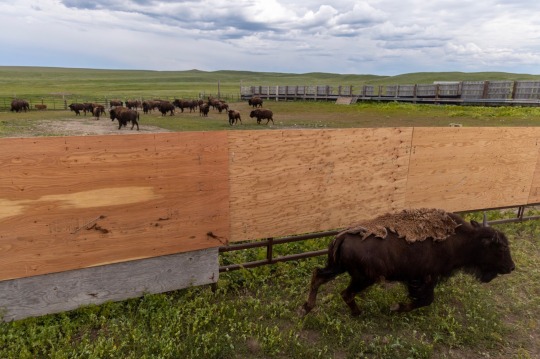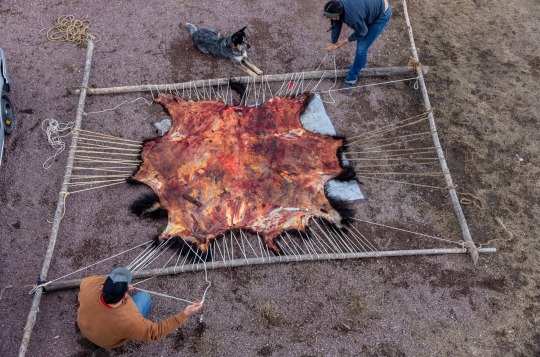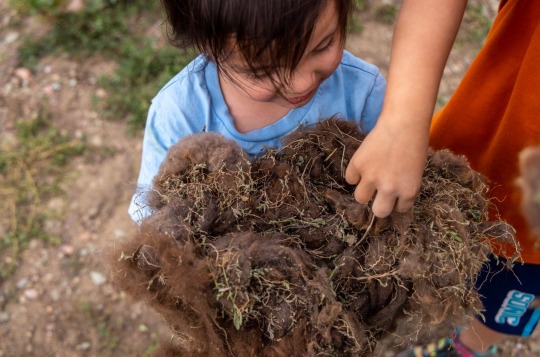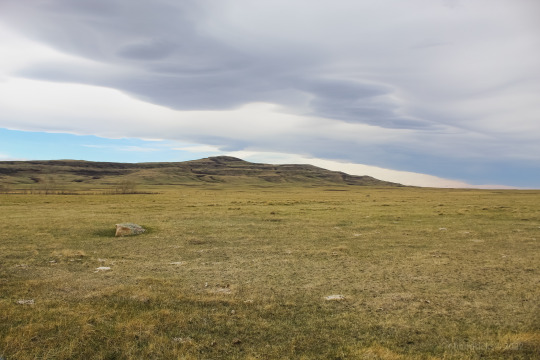#The Siksikaitsitapi (Blackfoot Confederacy)
Text
At Long Last, The American Buffalo Has Come Home
A conservation effort has returned bison to Blackfeet Nation tribal lands more than a century after the animal was nearly slaughtered to extinction.
— Photographs By Louise Johns | By Lailani Upham | Sunday July 09, 2023

“Nititawahsi” is the Blackfeet name for our land—the land where the iinnii (buffalo) live. Our people are Niitawahsin-nanni: the people of the land where the iinnii live.
As colonizers moved west, millions of buffalo were killed and brought to the edge of extinction. Millions more Native peoples were murdered, displaced, and forced to assimilate. By the end of the 19th century, only 300 buffalo were left in the wild and Native populations dropped to less than 300,000.
Now, after more than 150 years, iinnii have finally returned to their homeland, the Amskapi Pikuni (Blackfeet Nation) tribal lands, to roam free.

Forty-nine buffalo run out of their temporary enclosure towards Chief Mountain on the Blackfeet Reservation. The rest of the herd (about 70 buffalo) will join them at the end of the summer. Chief Mountain is not only prime buffalo habitat, but also a sacred place for Native people in both the U.S. and Canada.
“I can’t hardly describe the feeling that I have. I have this jittery feeling, goosebumps,” says Ervin Carlson, director of the Blackfeet Nation Buffalo Program. “It just feels so good to finally see them here in this place where we want them to be.”
On June 26, 49 iinnii were released into the wild at the base of our sacred Ninaistako (Chief Mountain), a Strong Miistaaki (Mountain) that stands tall like the warbonnets of Blackfeet warriors. This miistaaki towers along the border of the Blackfeet Nation, Glacier National Park in Montana, and Waterton National Park in Canada.
Our people, the Siksikaitsitapi (Blackfoot Confederacy) always believed the land we came from was a gift of the Creator, Ihtsi-pai-tapi-yopa. Our stories tell us that iinnii was created as a gift for our people as our life source. The iinnii were and still are our staff of life.
The iinnii coming back and being free on Blackfoot lands again is the beginning of reconciliation, says Cristina Mormorunni, director of Indigenous Led, the organization that leads cultural restoration and conservation of buffalo on Blackfoot lands. “This is the beginning of the truth being told about what happened, and they’re the best ambassadors,” she says.


Helen Augare, a Blackfeet knowledge keeper and director of the Blackfeet Community College Native Science Field Center, has been an integral voice in the return of buffalo to Chief Mountain for the past 15 years.
Now that the buffalo are free, she says “there’s so much still to reconnect to and learn from them.”
“What does that future look like and what [do] our children and grandchildren need to know to be able to help iinnii live a full and prosperous life with us again?” Augare says. “It entailed everything from healthy people, healthy land, healthy water, and most of all healthy relationships. That in itself requires a lot of healing, growth.”

Buffalo are corralled and sorted (calves from adults, and males from females) at the tribal-owned Buffalo Spirit Hills Ranch on June 25, 2023. The herd, originally from Canada’s Elk Island National Park, have been living on the ranch since 2016. The herd descends from the last remaining wild buffalo before they were nearly extirpated.

Blackfeet tribal member Wyett Wippert takes a photo of his daughter, Ruby, in front of the buffalo in their soft release pen at Chief Mountain. “We put so much of our hearts into getting them here,” he says. “It’s a very good feeling knowing that they are under Chief Mountain. People know what they’re going to be doing for their environment and for us as Blackfeet people.” The buffalo are held here for several hours to settle into their surroundings before being released into the wild.

Racine, Monroe, and director Ervin Carlson of the Blackfeet Buffalo Program, on June 25, 2023, after a long day of preparing buffalo to be released at Chief Mountain. “It’s a lot of work to get these animals to this point… they are wild buffalo,” Racine says. “Nobody can do it by themselves. It’s a real honor to be able to have the Iinnii here and to be doing this.”

Blackfeet tribal members Wyett Wippert and Christen Falcon work together to stretch their bison hide onto their handmade wooden frame, the first step in tanning the hide by hand at their home in East Glacier, Montana. on April 9, 2023.

“Bison are a keystone species, they are ecosystem drivers and engineers. They were here for thousands of years,” says Brandon Kittson, wildlife biologist for Blackfeet Fish and Wildlife. “Now having them back on this landscape is a good thing. It’s going to help revitalize some systems and help drive diversity among the different vegetation and communities found in this area.”

Children collect and examine clumps of buffalo fur from the corral at Buffalo Spirit Hills Ranch on June 25, 2023. The fur is integral to the health of the grassland ecosystem, as certain species of birds use it to line and insulate their nests.
— Photojournalist Louise Johns is a National Geographic Explorer. Her National Geographic Society-funded Project, "Buffalo Renaissance," is about Native American efforts to restore Bison to build cultural resiliency and ecological integrity.
#The National Geographic#American Buffalo#Photojournalist#Louise Johns#Buffalo Renaissance#Amskapi Pikuni (Blackfeet Nation)#Niitawahsin-Nanni#Chief Mountain#Ninaistako (Chief Mountain)#Glacier National Park in Montana#Waterton National Park in Canada#The Siksikaitsitapi (Blackfoot Confederacy)#Cristina Mormorunni#Helen Augare#Montana USA 🇺🇸#Canada 🇨🇦#Brandon Kittson Wildlife Biologist#National Geographic Explorer
5 notes
·
View notes
Photo


Blackfoot
The Blackfoot Confederacy, Niitsitapi or Siksikaitsitapi, is a historic collective name for linguistically related groups that make up the Blackfoot or Blackfeet people: the Siksika ("Blackfoot"), the Kainai or Blood ("Many Chiefs"), and two sections of the Peigan or Piikani ("Splotchy Robe") – the Northern Piikani (Aapátohsipikáni) and the Southern Piikani (Amskapi Piikani or Pikuni). Broader definitions include groups such as the Tsúùtínà (Sarcee) and A'aninin (Gros Ventre) who spoke quite different languages but allied with or joined the Blackfoot Confederacy.
https://en.wikipedia.org/wiki/Blackfoot_Confederacy
20 notes
·
View notes
Photo




Estipah-skikikini-kots
#alberta#head smashed in buffalo jump#UNESCO#heritage sites#Indigenous Peoples#blackfoot confederacy#Siksikaitsitapi#Niitsitapi#road trip
115 notes
·
View notes
Photo

CHARACTER BIO: MEDICINE HAT
[ Bio Page ] [ Relationships ] [ Trivia ]
Some Brief Definitions
(I realize that some terms aren’t familiar to people outside of Canada/North America so I will elaborate on them here. Many definitions are particular to First Nations cultures and should thus be treated respectfully!)
Blackfoot - The English name for the Niitsitapi or the Siksikaitsitapi, a confederacy made up of linguistically related First Nations. The Kainai (”Blood”) are one of these nations.
Cree - The English name (from the French) for the Néhinaw or the Néhiyaw, one of the largest First Nations groups in North America.
Tepee - a tent traditionally made of animal skins stretched over poles most typically associated with First Nations of the great plains in North America. Tepees today are usually made with canvas. A sculpture rather than a dwelling, the Saamis Tepee is 215 feet tall and made of 800 tons of steel.
Buffalo Jump - a natural cliff where First Nations people would historically steer bison in order to hunt, kill, harvest, and process them.
Coulee - from the French “couler” “to flow”, refers to several geographical formations. In Southern Alberta, it usually refers to a valley that was carved by glaciers and eroded by water or wind.
Pinto - a description of a horse’s coat, typically white with large spots of another colour.
Transcription below the cut
Although Calgary often claims the title, Medicine Hat is the Sunniest City in Canada and receives an average of 330 days (2544 hours) of sunlight in a year!
Medicine Hat represents ancient boundaries between the Blackfoot and the Cree and has long been the site of a "breathing hole" for water spirits on the South Saskatchewan River, untouched by winter ice. The city's name comes from local indigenous oral history.
One variation of the legend describes a Kainai hunter sent to locate food in time of starvation. A great serpent rises from the river and demands the life of the hunter's wife in exchange for a medicine hat, a saamis, which grants the hunter the power to save his people. This story is depicted in brick at city hall.
Medicine Hat's historic gas lamps still light public streets. Although many gas wells are still operating after over a century, these lamps are now lit with LEDs.
The Saamis Tepee is Medicine Hat's most visible landmark and overlooks Seven Person's coulee, the location of an ancient buffalo jump and rich archaeological site. The tepee was originally made for the Calgary Olympics and was brought to
Medicine Hat in 1991.
Medicine Hat is well known for its historic clay district that produced all sorts of pottery and the bricks for many buildings lining the streets of downtown.
Cypress Hills Interprovincial Park spans the border between Alberta and Saskatchewan and is a short trip from Medicine Hat. The Alberta side boasts the most species of orchids on the prairies; 18 different varieties are known.
A Medicine Hat horse is a pinto with a distinct patch of colour over the ears and head, occasionally with a splash of colour across the chest like a shield, and has been a lucky sighting for centuries. A Medicine Hat horse with blue eyes is even more fortuitous!
#aph oc#hetalia oc#hws oc#aph medicine hat#oc tober#oc_tober#projectcanada cities#battle ref#pc: medicine hat#madeline hargrave#digital art#clip studio paint
17 notes
·
View notes
Text
Indigenous Languages Challenge #2: Proto-Algonquian
(see bottom of post for a quick introduction to language families and proto-languages, if you’re not familiar with my terminology here.)
Name of the language is Proto-Algonquian; since we have no record of this language actually existing, we don’t know what its speakers might have called themselves, though we could guess. Looking at the root of the Wôpanâak word hutuwôk (”that [language] which they can speak to each other”), from the first post I made in this series, we might guess that it’s related to *eϴketoᐧmakatwi, the verb “speak,” but I haven’t found any writings on this yet. The word “algonquian” itself may descend from a Maliseet word, elakómkwik, meaning “they who are our allies/relatives,” whose root I haven’t been able to find.
Basic Information - We get to Proto-Algonquian by pulling back from Wôpanâak to look at the entire Algonquian language family; this is sometimes subdivided into Plains Algonquian (such as Blackfoot / Siksiká), Central Algonquian (such as Ojibwe / Ojibwemowin / Anishinaabemowin), and Eastern Algonquian (such as Wôpanâak), but we can argue for a while about how the sub-groups should actually be split up. (There are many more in the Algonquin language family than I’ve listed here, of course).
History - Of course, much like we don’t have direct record of Proto-Algonquian, we don’t have direct record of who its speakers were; however, based on the geography and history of the groups in the language family, its guessed that they were a largely settled group in the central-south Canada area; northeast of the Great Lakes. Part of the point of this challenge is to recognize indigenous people and languages as living and existent, not historical curiosities, which I’m already stretching by talking about proto-languages, so instead of continuing to tell you about that, I’ll give you a little information on those two randomly-chosen subgroups I mentioned above, excluding Wôpanâak since I already talked about it.
The Blackfoot Confederacy (Niitsitapi or Siksikaitsitapi) describes four groups in Montana and in southwestern Canada. They were originally nomadic inhabitants of the Great Plains area. There’s several strong language revitalization and education movements among the Blackfoot Confederacy. The Piegan Institute, founded by Darrell Robes-Kipp, supports several immersion schools; and Montana radio station KBWG broadcasts shows in the language.
The Ojibwa or Chippewa (this is still a wide group, and there are so many different names for them, based on exact langauge, dialect, and area, that there’s an entire wikipedia article List of Ojibwa ethnonyms) are an Anishinaabe people and members of the Council of Three Fires; they live largely in an area I can best describe as south-middle-eastern Canada, north of the Great Lakes and sweeping a bit east and west, as well as a bit south into the United States. In 2001 an Ojibwe-language school, Waakoododaading (”the place where we help each other”) was founded by a community effort in Wisconsin; there were many people involved, but some of the original founders still working with the school are Keller Paap and Lisa LaRonge.
Linguistic revitalization - Algonquian has been one of the more heavily studied of the American language families; a first attempt at its reconstruction was published by one Leonard Bloomfield in the early 1900s, not long after Proto-Indo-European obtained a widely accepted form. A dictionary of Proto-Algonquian was published here (x) by the Algonquian Dictionaries Project, a subsidiary of the Algonquian Linguistic Atlas. The dictionary project makes available here (x) many resources on Algonquian languages; the Atlas also offers great resources for learning and use of these languages, such as fonts, conversation audios and manuals, and this super neat “terminology forum” (x) with common and important phrases.
Support - I wasn’t able to find an active donation site for Waakoododaading, and the Algonquian Dictionaries Project is an academic project which gains funding through grants, not donations, but...
Support the Piegan Institute here!
Linguistic Information:
Phonology - As we saw with Wôpanâak , voicing / aspiration were not phonemic in Proto-Algonquian. The consonant inventory is a bit restricted as a result, but, notably, there’s a palatal or post-alveolar series as well as alveolar (again, as in Wôpanâak). The language did have at least one approximant/trill in the form of /l/, or /ɹ/. And, like Wôpanâak, there are four basic vowels and a length distinction, though nasalization was probably not phonemic. Like its daughter language, Proto-Algonquian was likely distinctive for its abundance of multi-vowel and semivowel-vowel syllables.
Morphology - Again, like Wôpanâak (and like many proto-languages), Proto-Algonquian is pretty heavily marked. It heavily uses a proximate-obviative distinction - much like the difference between “this” and “that,” this is the distinction between an object/person who is close to / part of / more relevant to the conversation, vs. one who is far away / not participating / less relevant. The distinction is used with pronouns to keep track of third person referents (as if you were referring to this-he and that-he, instead of leaving it unclear who a particular “he” refers to), for instance.
Syntax - I wasn’t able to find a ton on the syntax of Proto-Algonquian (it’s even more difficult to reconstruct grammars than phonologies, and heavily-marked languages tend towards less rigid syntax anyways), so, in interest of getting this posted, I will refrain from trying to find and get an interesting factoid from a paper on Proto-Algonquian syntax.
Vocabulary - Like Wôpanâak, many Algonquian languages have lent words to English / American terms and place-names. From Massachusetts, which we saw before, to Michigan (mishigamaa, Ojibwe “big water”), to animals such as moose and woodchucks (from Cree otchek or Ojibwe otchig, altered to match “wood” [now you know how much wood a woodchuck can chuck: none]), and even the word tuxedo (named for the town the style originated in, which in turn took its name from a Munsee-langauge place-name).
Information from one of the listed sources, Wikipedia, World Atlas of Language Structures, Online Etymology Dictionary, etc.
In case you don’t know what I’m talking about here, a “proto” language is one for which we have no record (living speakers or writings), but which we can reconstruct based on the similarities of languages we do know about. A proto-language is constructed for a language family, a set of languages that we know are related because of similarities in their words and grammars. Roughly speaking, this means comparing words we think are related, and hypothesizing an ancestor word which can produce all of the descendants via regular sound changes; of course, it tends to get a lot more complicated than that might sound.
Often, because of the relatively short history of written language, more than one proto-language can be constructed in the history of a language family; the Algonquin language family is itself part of the Algic family (unfortunately, or perhaps fortunately, linguistics haven’t followed biologists in the order-phylum-class-etc-etc classification, so everything’s a family of different sizes), along with Wiyot and Yurok, and we have another reconstructed language, Proto-Algic, from which they all descend.
As an example, Wikipedia helpfully provides the word for “woman” in many Algonquin languages; a random sample of them is okwéew, iskwew, and aakííwa. Clearly related, right? The hypothesized root for these is *eϴkweᐧwa; so the major changes we have are deleting /ϴ/ (the sound at the end of “with”) or replacing it with /s/ (if this seems improbable, considered how often non-native speakers pronounce English “the” like “ze;” the two sounds are, by linguistic standards, quite similar), and messing about with the vowels. If I had the time and energy to pull up more words and roots, we’d expect to see regular correspondences between languages, like “o,” “i,” and “aa” appearing in the same word.
As a note, reconstructed words are generally marked with * to indicate that they aren’t actually attested.
#iyil-challenge#linguists#information#algonquian#algonquin#Sorry this took forever to write#there's not a ton of available information on the language and I kept getting sidetracked by researching the daughter languages.
26 notes
·
View notes
Text
Nose Hill Siksikaitsitapi Medicine Wheel
Nose Hill Siksikaitsitapi Medicine Wheel
[ad_1]
Stand at this medicine wheel, and you’ll see sweeping views of prairieland interrupted by the Calgary skyline looming in the distance. The monument is a peaceful spot meant to make visitors stop and take a moment to appreciate their surroundings and the human history tied to the land.
Members of the Blood Tribe built the medicine wheel in 2015 as part of an annual Blackfoot Confederacy…
View On WordPress
0 notes